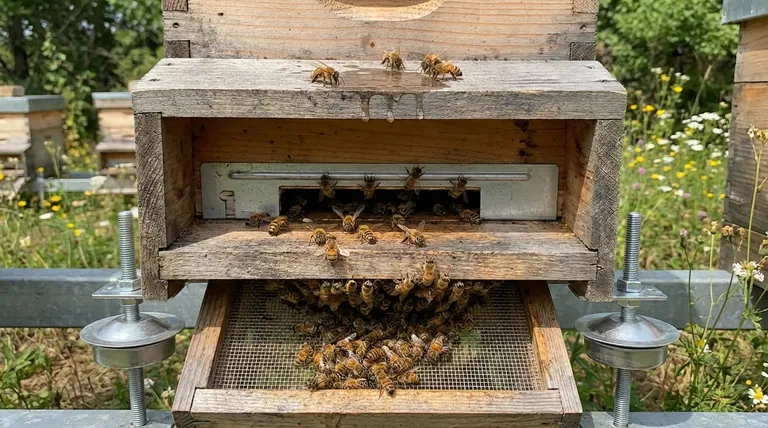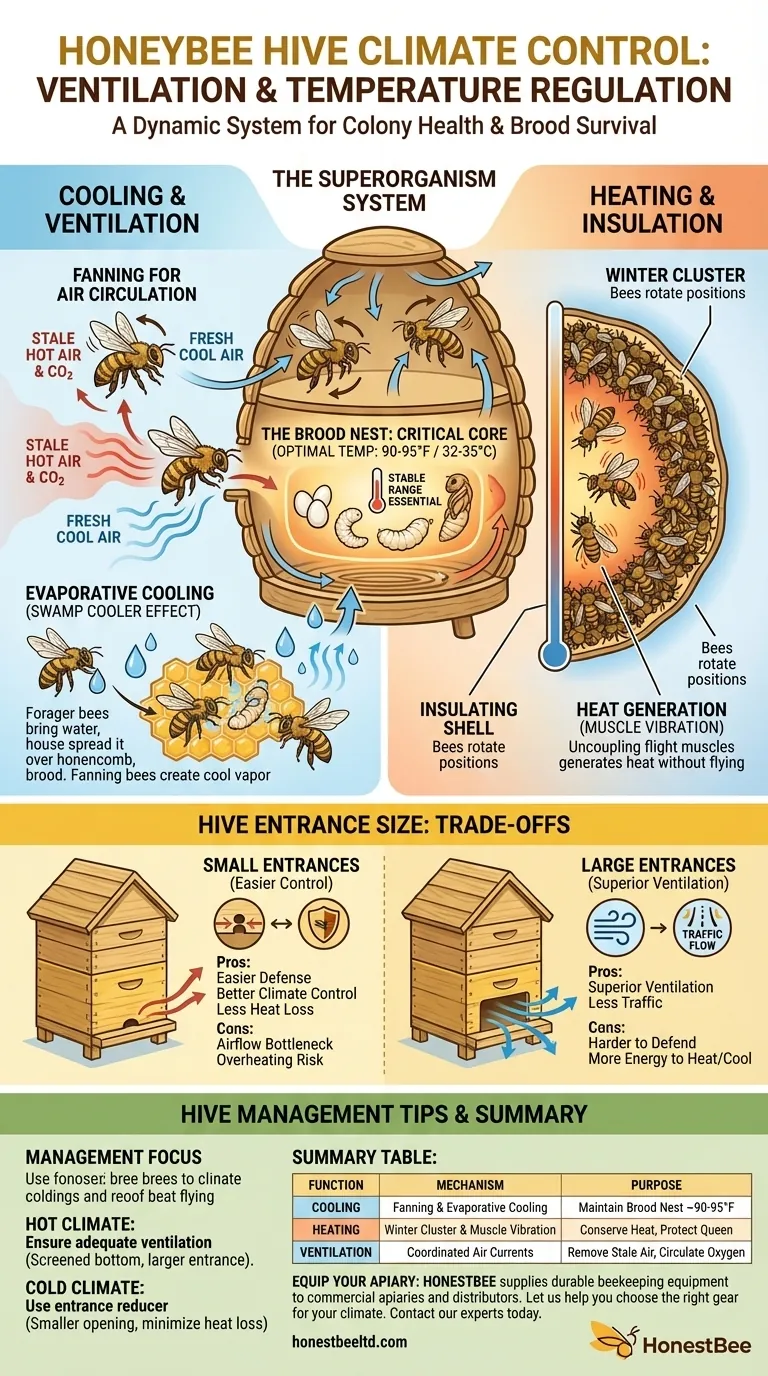At its core, a honeybee colony regulates hive temperature and ventilation through a sophisticated system of collective behaviors. They actively manage their internal environment by generating heat when needed and creating cooling air currents, ensuring the survival and development of their young.
The key insight is that a beehive is not a passive structure; it's a dynamic, climate-controlled environment actively managed by the bees themselves. They function as a single "superorganism" to precisely regulate the temperature of their central brood nest.

The Brood Nest: The Colony's Critical Core
A bee colony's primary goal is to maintain a stable environment for its most vulnerable members: the eggs, larvae, and pupae. This central nursery is known as the brood nest.
### Why Temperature is Non-Negotiable
The developing brood is extremely sensitive to temperature fluctuations. The colony must maintain the brood nest within a very narrow temperature range, typically around 90-95°F (32-35°C), for the young to develop properly.
This precise control is the driving force behind all of the hive's heating and cooling behaviors.
Cooling and Ventilation Mechanisms
When the hive overheats, bees work together to actively remove heat and circulate fresh air.
### Fanning for Air Circulation
Specialized worker bees position themselves at the hive entrance and throughout the interior, facing the same direction. They then rapidly beat their wings to create a coordinated air current.
This fanning action pushes stale, hot, carbon dioxide-heavy air out of one side of the entrance while pulling fresh, cooler air in through the other.
### Evaporative Cooling
On extremely hot days, fanning alone isn't enough. Forager bees will collect water instead of nectar and bring it back to the hive.
Inside, house bees spread this water over the surfaces of the honeycomb and on the developing brood. Other bees then fan their wings over the water, creating an evaporative cooling effect, much like a swamp cooler.
Heating and Insulation Mechanisms
In cold weather, the colony's priority shifts from cooling to heat generation and conservation.
### The Winter Cluster
As temperatures drop, the entire colony contracts into a tight ball known as the winter cluster. The bees on the outer layer press tightly together, forming an insulating shell.
This shell can be several inches thick, protecting the bees in the interior from the cold. Bees will rotate positions, moving from the cold outer layer to the warm interior to ensure no single bee freezes.
### Generating Heat Through Vibration
The bees inside the core of the winter cluster are responsible for generating heat. They do this by uncoupling their wings and vibrating their powerful flight muscles.
This muscular friction generates significant heat without the bees actually flying, warming the center of the cluster to the temperature required to keep the queen and the colony alive.
Understanding the Trade-offs: Hive Entrance Size
The references correctly note that bees can manage ventilation with different entrance sizes, but each approach has inherent trade-offs.
### Small Entrances
A smaller entrance is easier for the colony to defend against predators and other bees. It also makes it much easier to control the internal climate, as there is less space for heat to escape in the winter or for hot air to enter in the summer.
However, a small entrance can become a bottleneck, restricting airflow and making it harder for the bees to cool the hive effectively on very hot days.
### Large Entrances
A larger entrance provides superior ventilation, which is a major advantage in hot climates. It also reduces "traffic jams" for foraging bees.
The downside is that it is much harder to defend. It also creates a larger opening that the bees must work harder to heat or cool, potentially expending more energy to maintain the stable temperature of the brood nest.
Applying This to Hive Management
Understanding these natural behaviors is critical for any beekeeper looking to support their colony's health.
- If your primary focus is supporting a colony in a hot climate: Ensure the hive has adequate ventilation, potentially with a screened bottom board and a larger, full-width entrance during the summer.
- If your primary focus is overwintering a colony in a cold climate: Use an entrance reducer to create a smaller, more defensible opening that minimizes heat loss and prevents pests from entering.
The bees' ability to collectively manage their environment is one of the most remarkable feats in the natural world.
Summary Table:
| Function | Mechanism | Purpose |
|---|---|---|
| Cooling | Fanning & Evaporative Cooling | Maintain brood nest at ~90-95°F (32-35°C) in heat |
| Heating | Winter Cluster & Muscle Vibration | Conserve heat and protect the queen in cold |
| Ventilation | Coordinated Air Currents | Remove stale air and circulate fresh oxygen |
Equip your apiary with the right tools to support your bees' natural climate control. Proper hive equipment is essential for colony health and productivity. HONESTBEE supplies durable, well-designed beekeeping supplies and equipment to commercial apiaries and beekeeping equipment distributors through wholesale-focused operations. Let us help you choose the right gear for your climate and management goals. Contact our experts today to discuss your needs and explore our wholesale catalog.
Visual Guide

Related Products
- Metal Hive Feet Bee Hive Stand for Ant Protection
- Metal Bee Hive Stand Bee Box Stand for Beekeeping
- Plastic Bee Hive Stand for Beekeeping
- Steel Round Disc Entrance Reducer for Flexzion Bee Hive Nuc Box Gate
- Black Plastic Beetle Barn Hive Beetle Trap for Beehives
People Also Ask
- How do bees regulate the temperature of their hive during the summer? Discover Their Natural Cooling System
- What is the role of oxalic acid in plants? A Key to Plant Defense and Internal Regulation
- What is the best height for a hive stand? Optimize for Pest Control and Beekeeper Ergonomics
- What is the best stand for a beehive? A Practical Guide to Durability & Stability
- Why is it important to keep a beehive dry? Ensure Colony Health and Hive Longevity













